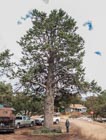
A very large tree in habitat (that has been invaded by a housing development) in Pine, Arizona [C.J. Earle, 2012.12.26].
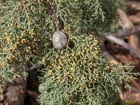
Foliage and cones on the tree shown above [C.J. Earle, 2012.12.26].
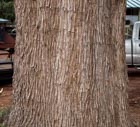
Bark on the tree shown above [C.J. Earle, 2012.12.26].
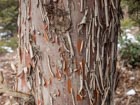
Bark on a younger and smaller tree [C.J. Earle, 2012.12.26].
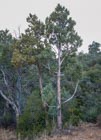
A typical tree in habitat, along SR-87 near the Mt. Ord trailhead, Mazatzal Mtns., Arizona [C.J. Earle, 2012.12.26].
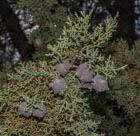
Foliage and cones on the tree shown above [C.J. Earle, 2012.12.26].
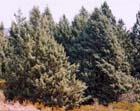
Trees near Oak Creek outside of Sedona, Arizona [Jeff Bisbee].
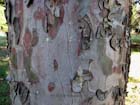
Bark of a tree at Merlin May Arboretum, Oregon [Frank Callahan, 2012].

Conservation Status

Hesperocyparis glabra
(Sudw.) Bartel (2009)
Common names
Smooth Arizona, smooth, or Arizona cypress (Peattie 1950).
Taxonomic notes
Synonymy: see POWO (accessed 2023.12.16). Type: Verde Canyon, Yavapai Co., Arizona. See Hesperocyparis arizonica for discussion of the relationship between various taxa assigned by some authors to H. arizonica. See Hesperocyparis for a discussion of the relationship between this and other, closely related Hesperocyparis taxa in northwest Mexico and the adjacent Southwest U.S.
Callitropsis nootkatensis in cultivation has spontaneously hybridized with H. glabra. The hybrid is x Hesperotropsis notabilis; see POWO (accessed 2023.12.16) for synonymy.
Description
"A tree, when older, with bark thin and cherry-red, or dark-brown as mahagony, exfoliating in thin plates; foliage like that of the typical variety, only with more prominent glands; seeds 4-5 mm long, bluish pruinose" (Vidakovic 1991). It generally resembles Hesperocyparis arizonica, but differs in having smooth reddish bark exfoliating in thin flakes and strips, and in having conspicuously, actively glandular foliage (Farjon 2005).
Distribution and Ecology
USA: Arizona: Coconino, Gila, Maricopa and Yavapai counties, at 1200-1680 m elevation in piñon-juniper woodlands, usually on poor desert soils of silicate origin (Farjon 2005). Hardy to Zone 7 (cold hardiness limit between -17.7°C and -12.2°C) (Bannister and Neuner 2001).
Distribution data from USGS (1999). Points plotted as tree icons represent isolated or approximate locations.
The range is roughly bounded by Sedona, Payson, and the Mazatzal Mountains (Adams et al. 2010; see map). Common associates include Pinus edulis, P. scopulorum, Juniperus deppeana, J. scopulorum, and J. osteosperma (Farjon 2005).
Remarkable Specimens
The largest specimen on record has height 21.3 m and dbh 158 cm; it is in Tonto National Forest (American Forests 2000). The largest known outside of the species' native range is a specimen 24.7 m tall and 350 cm girth (114 cm dbh) in the Jardin Massey, Tarbes, Hautes-Pyrénées, France, as measured 2020.05.15 by Dominique Béziat (Monumental Trees 2020).
Ethnobotany
No data as of 2023.12.16.
Observations
No data as of 2023.02.21.
Remarks
The epithet glabra means "smooth", in reference to the bark.
Citations
Adams, R. P., J. A. Bartel, D. Thornburg, and A. Allgood. 2010. Geographic variation in the leaf essential oils of Hesperocyparis arizonica and H. glabra. Phytologia 92(3):366-387. Available at www.phytologia.org.
American Forests 2000. The National Register of Big Trees 2000. Washington, DC: American Forests.
Bartel 2009: described in Adams, R. P., J. A. Bartel and R. A. Price. 2009. A new genus, Hesperocyparis, for the cypresses of the western hemisphere. Phytologia 91(1):160-185.
Sudworth. 1910. A new cypress for Arizona. American Forestry 16: 88-90. http://www.cupressus.net/CUglabraSudworth.html, courtesy of the Cupressus Conservation Project website.
See also
Adams, R. P. and J. A. Bartel. Geographic variation in Hesperocyparis (Cupressus) arizonica and H. glabra: RAPDs analysis. Phytologia 91(1):244-250.
Bisbee, Jeff. 2006. Photos at the Cupressus Conservation Project website.
Wolf (1948) and Farjon (2005) each provide a detailed account, with illustrations.








